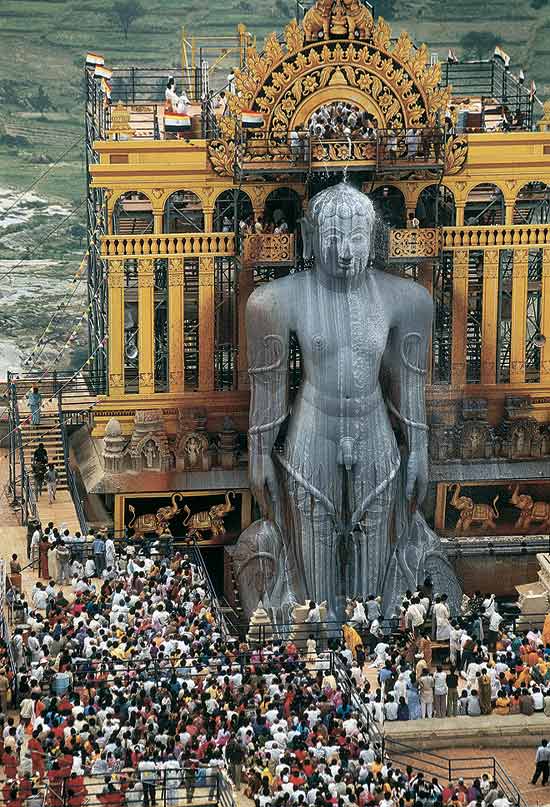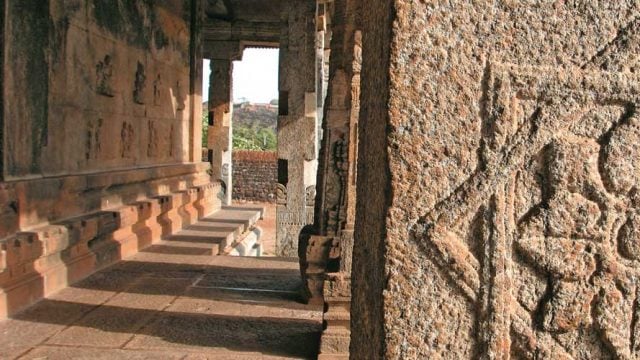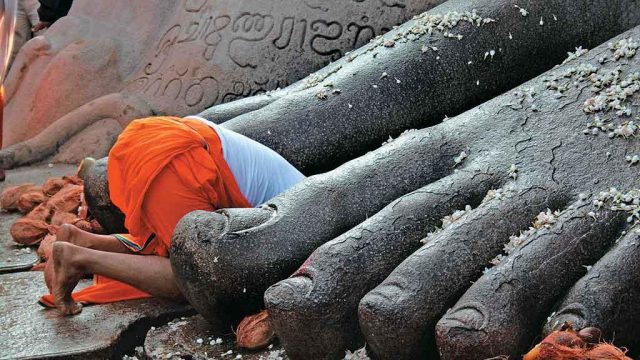A hairless, black and orange caterpillar, with white spots, winds into a corner of one of the
In season, between September and July, Shravanabelagola gets about 4000 visitors a day. It is the highlight of the Jain pilgrimage circuit in Karnataka. Even during the off-season, says the official at Tourist Information, about 500 people come every day, but just now we seem to have plenty of elbow room. The village, a string of vegetarian hotels and shops selling 10-inch and 5-inch Gomateswaras in every colour, lies between the two granite hills of Vindhyagiri and Chandragiri, which are dotted with shrines to the 24 tirthankars or ‘ford-crossers’.
The climb up Vindhyagiri is steeper than we expected, each pitted granite step on the boulder face sloped a bit down and back, and since we haven’t been climbing in reverent silence we are very quickly out of breath. We hang on to the galvanized iron railing so as not to slide backward, our bare toes curling into the stone. Two men trot down the ‘down’ stairs, offering us a doli, a capacious cane chair obviously made for more ample figures. We wave them off, and we take our minds off the climb by rubbing at the lichen on the stone, talking of our grandmother, and calculating that 17.5 metres should be well over 54 feet.
The man himself was apparently larger than life. Bahubali was the son of the second wife of King Rishabhadeva of Ayodhya, who became Adinath, the first of the 24 tirthankars. The son is described as being taller and stronger than his 99 brothers. When Rishabhadeva renounced his kingdom, Bahubali fought his brother, Bharat, for succession in a three-part duel. First he stared his brother down, then the two splashed each other with water till Bharat gave in. Finally, Bahubali overpowered Bharat in a wrestling bout. But at the moment of triumph, he realized the futility of his struggle and left for the forest to seek liberation. For years he meditated in the kayotsarga pose, while creepers wound around his limbs and anthills rose at his feet, till his soul found release.
At no part of the climb is there a hint of the colossus at the top. But there are, as always, shrines all the way up the hill. The first encloses Kushmandini Devi, the yakshi or guardian goddess who watches over Bahubali. It is said that the goddess appeared in a dream to Chamundaraya, telling him to shoot a golden arrow to the top of Vindhyagiri. In the legend, the arrow shattered rock and uncovered the enormous idol of Bahubali. But the guidebooks say the image was commissioned by Chamundaraya and sculpted by Aristenemi about a thousand years ago.
Two-thirds of the way up is a mandapam that houses idols of three tirthankars gleaming black among squat pillars. It’s a welcome stretch of level ground from which to overlook the tiled roofs of the village and the shivering green square of a temple tank. Scooters purr around the tank, and a white eagle hangs in the air, staggering against the breeze.
We turn our faces back to the hill. A pair of feet, only life-size, bulges from the rock, marking the spot at which some monk left his body, I forget his name. We go through a gate, turning again and again till we have lost direction. Finally there is a temple courtyard. And, in the sudden sunshine, a pair of huge feet, ankles, shins, creepers spiraling symmetrically on broad thighs and embracing massive hips.
‘It’s smaller than I thought.’ ‘What do you mean? It’s huge. Is the Statue of Liberty bigger than this?’ ‘Oh yes. But of course this is said to be the largest monolithic statue.’ In fact, I have the measurements in a pamphlet I bought for ten rupees in the tourist office below. The head, 11 feet. Navel to neckline, 10 feet 11 inches. Length of arms, 30 feet. Length of nose, 3 feet 9 inches. Length of ears, 5 feet 10 inches. Length of penis, 4 feet.
I press back as far as I can against the temple walls, trying to get a feeling of the whole, but I am cabined, cribbed. I have a crick in my neck. We circle clockwise in the path to see if we can get to the upper gallery, but the gate at the top of the steps is locked, probably against post-exam potential suicides. So we return to his feet and throw our heads back again.
However we look at it, it is a strangely disproportionate body, to be expected, perhaps, in a wrestler. The image is ascetically spare, powerful. Every feature expresses stylized, inert mass¾the broad nose and jaw, the short neck, too-broad shoulders, the jewel-like nipples, the stomach wrinkles. But it is also childlike, with rounded cheeks, parenthetical creases at the knees, and a rather sub-adult penis, rooted in two slack wrinkles and ending in a rosebud twirl. A dialogue of power and restraint carved in stone. A giant who could crush his opponent swift as thought, but didn’t. Faced with Arjuna’s dilemma, Bahubali took the other road.
To relieve our necks, and also to distance ourselves from the priest with a flame on a platter and a mantra on his lips, we look at the snakes winding in and out of the anthills at the feet of the ever-still monk. Apart from the exuberantly carved dvarapalakas at Bahubali’s feet, which look like they were hauled in from the more voluptuous temples at Belur and Halebid, all is restraint, contemplation. The temple walls are ornamented almost randomly, and odd images float at different heights. Here a fish, there a monkey exploring a beehive, reminder of the illusory nature of our happiness on earth.
The slippery walk back down the hill leaves us with trembling knees. In the shadow of a pillar we eat our packed idlis and bananas. It is an appropriately frugal meal. And besides, that’s all we’ve brought.
The architecture at the bottom of the hill is all bustle, the here and now. At the Jain math, idols swarm and paintings riot along the walls. Tiny green and yellow people warring, playing, praying, marrying, tending their gardens, kitchens, and closets, and their gods. From here, the monk on the hill is invisible and, by the time we get back on the highway to Bangalore, I’m shuffling through my postcards to keep him in my mind’s eye.
(Shravanabelagola is 160 km west of Bangalore, a comfortable three-hour drive or bus ride. Basic accommodation is available at pilgrim hostels.)
Jainism
Shravanabelagola
Leave a Reply
You must be logged in to post a comment.




